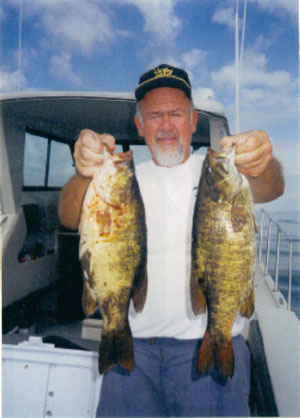|
Deep Artificial "Jumper" Techniques
By Capt. Phil Cadez
Walleye fishing has been the main
attraction to Lake Erie for the past 30 years.  The lakes made a super comeback even though alien species have
been introduced into the lake. Zebra muscles, white perch and now the
gobi have
infiltrated the lake.
The only fishing that has remained constant over the last half century
has been the smallmouth bass fishery.
The lakes made a super comeback even though alien species have
been introduced into the lake. Zebra muscles, white perch and now the
gobi have
infiltrated the lake.
The only fishing that has remained constant over the last half century
has been the smallmouth bass fishery.
Lake Erie has always been one of the top 10
smallmouth areas in North America.
Itís many limestone islands and sunken
reefs provide ample habitat for lots of bronzebacks.
Even with the threat of gobies taking over the rocky bottom of
our lake, these sportfish will survive.
Many guides have had big smallies spit out
gobies in their cooler so we know theyíre eating them.
Each year I see more and more bass clubs
have their tournaments on Lake Erie. In the spring the
bass islands have bass boats galore zipping up and down their
shorelines. The anglers are the ďpuristĒ, the true
sportfishermen when they must only use artificial baits.
Most practice catch and release and donít want to hurt our
fishery.
Lake
Erie, being a shallow lake, will warm to over 76 degrees in August and
early September. The ďbronzebacksĒ
seek cooler water near the drop-offs and will sometimes go as deep as 35
feet. Itís harder to fish artificial at deeper depths unless you know
what youíre doing. I
would venture to say that most anglers use
softcraws because itís easy and most effective.
Iím
going to focus on the ardent die hard artificial bass fishermen.
These ďpuristĒ anglers say that itís like bow hunting for deer
instead of using a rifle or shotgun.
It might be the satisfaction of hooking on a big ďjumperĒ in keep
water with an artificial bait and then knowing heís going to surface
shortly trying to spit out this bait. Iím going to deal with the depths
of 20 feet or more and relate our successes with the methods weíve come
up with.
Any of the bass islands or
Pelee Island in Canada have
ideal
structure to start working your magic.
Try and look for 2 to 4 feet changes in depth on uneven rocky
bottoms. If the drift is slow because the winds are light and variable
thereís no need to anchor. Have a
throwable
marker ready to
throw if you found a pocket of active ďsmalliesĒ.
This will enable to you cruise slowly around and start the drift again.
Tackle is up to the
individual . Bass
fishermen prefer bait casting reels spooled with 10 or 12 lb
line .
The composite rods are usually light but have some backbone.
Most of the localís prefer open face spinning tackle spooled with
6 to 10 lb line. The
rods are shorter thought, ranging from 5 to 6 feet in length.
A few sportfishermen rely on a mini
openfaced reel with an
ultralight rod for more fun.
The most effective
artificial bait
that you can use at depths over 20 feet is the tube and salt body jigs.
Thereís also variations of power grubs but
most will stick with tube jigs. I know thereís lotís of different
plastic bodies you can place on a jig but letís
work with the easiest. The tube jig is easy to use and will
hang up far less than other conventional baits.
Itís really only about a plastic tube that covers the head of a special
jig head which looks like a hook with the lead imbedded threw it.
The lead is narrow so the body will slip on easily. Once the
tube is placed over the jig head the only thing exposed are the eye to
tie on your line and the end of the hook thatís protruding from the open
end of the tube.
Colors vary according to water clarify
and the fishís natural bait. Since smallmouth love crawfish, anything
remotely resembling this crustation will
give you an edge.
Popular colors are pumpkin (brown), chartreuse, plum, watermelon (a blue
variation), black, silver and the list goes on.
Salt jigs are the same as tube jigs but theyíve been impregnated
with a salty taste for the fish. Most of these tube jigs are between
2-1/2 to 4 inches. After
youíve pulled the tube over the jig head, tie the line directly to the
exposed eye of the hook.
Donít use a swivel. A few anglers prefer these small clips but using a
big swivel will be counter productive.
Since youíre mainly concerned with
working the bottom, thereís only a few
presentations. If your
drift is moderate to slow you can drag the jig on the bottom popping it
every once and a while to give a jumping effect.
In 20 foot of water you might use anywhere from ľ oz to ĺ ox jigs
depending on the speed of the drift.
Always be ready, donít leave much slack when youíre working the
jig. Lotís of times the fish will pick it up on the
drop. Any bumps you might get Ė set the hook fast and keep the tip of
the rod up. Have your
drag adjusted so the fish can run if it wants to.
Never horse a smallmouth especially if you find out heís got some
shoulders. Big fish stay
in the water because theyíre smart or youíve made dumb mistakes. Donít
panic Ė take it easy. Iíve seen so many trophies get away because the
angler got excited.
If the drift is moderate and you prefer
casting instead of drifting, throw your line parallel to the drift.
You can then let it hit the bottom and retrieve the jig on a
swing cast which will keep you near the bottom longer.
This will also enable you to control your speed of
retrieve parallel to the drift. On these
swing cast you might want to go with a little heavier jig head which
will let you cast farther and work the bottom longer.
You can drift over a structure that
youíve found and marked with a throwable
bottle or ring buoy or you can anchor over this hot spot for a while.
Having a long anchor line will let you feed out the line and deep
working the same area only down wind of your hot spot.
If you want to try something different
then a tube jig you can throw a beetle spin, road runner type lure.
Itís just a grub body with a exterior
small spinner. Rattle trap lures will get down to where the fish are.
Any bodybait that resembles a small fish
will work if it has a large lip on it.
This will get it down deeper as you pull the bait in.
Some anglers use a vertical jig vibrating bait such as a cicada,
sonar or silver buddy. Gold, silver and chartreuse will work the best.
Check out my website at:
www.cadez-charters.com |





